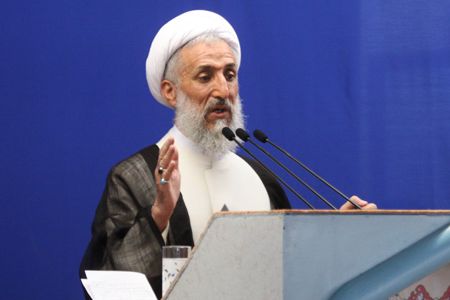Senior Cleric: Iran to Give Crushing Response to Aggressors

 The Iranian armed forces will make any aggressor repent its action, Tehran’s provisional Friday Prayers Leader Kazzem Sediqi said a few days after the country’s forces brought down a US spy drone in the Eastern parts of Iran.
The Iranian armed forces will make any aggressor repent its action, Tehran’s provisional Friday Prayers Leader Kazzem Sediqi said a few days after the country’s forces brought down a US spy drone in the Eastern parts of Iran.
“Our nation is brave and is not intimidated by threats,” Sediqi said during his second Friday Prayers sermon on Tehran University Campus today, and added, “The Iranian nation and the glorious armed forces are standing firm and strong on the scene of defense and they are not fearful of any power.”
“They give such a response to any aggressor that it will make them regret their aggression,” he added.
He further praised the Iranian armed forces for downing the highly sophisticated stealth drone, saying “the United States’ most advanced spying tool” which was seen as a hawk was hunted by Iran’s hunters.
Iran announced on Sunday that its defense forces downed the aircraft through a sophisticated cyber attack.
The drone is the first such loss by the US.
US officials have described the loss of the aircraft in Iran as a setback and a fatal blow to the stealth drone program.
The RQ-170 has special coatings and a batwing shape designed to help it penetrate other nations’ air defenses undetected. The existence of the aircraft, which is made by Lockheed Martin, has been known since 2009, when a model was photographed at the main US airfield in Kandahar, Afghanistan.
The unmanned surveillance plane lost by the United States in Iran was a stealth aircraft being used for secret missions by the CIA, US officials admitted earlier this week.
The aircraft is among the highly sensitive surveillance platform in the CIA’s fleet that was shaped and designed to evade enemy defenses.
Current and former Washington defense officials said even the US military cannot use such a highly sophisticated stealth aircraft as the country is in relatively short supply and is only flown by the CIA.
The Iranian state broadcaster Thursday evening released the first images of the highly advanced US stealth spy drone.
Commander of the Islamic Revolution Guards Corps (IRGC) Aerospace Forces Brigadier General Amir Ali Hajizadeh appeared on TV last night to explain how Iranian forces downed the United States’ highly advanced radar-evading spy drone last week.
“Recently, our collected intelligence and precise electronic monitoring revealed that this aircraft intended to infiltrate our country’s airspace for spying missions,” the General said, and added, “After it entered the Eastern parts of the country, this aircraft fell into the trap of our armed forces and was downed in Iran with minimum damage.”
“The wing-to-wing width of the RQ-170 Sentinel drone is around 26 meters with a length of 4.5 meters and height of 1.84 meters.”
“The drone is equipped with highly advanced surveillance, data gathering, electronic communication and radar systems,” he continued.
“As far as its platform and coating are concerned, this kind of plane has been designed to evade radar systems and from the view point of technology it is amongst the most recent types of advanced aircraft used by the US,” the IRGC commander added.
“The technology used in this aircraft had already been used in B2 and F35 planes,” Hajizadeh said, and added, “This aircraft is controlled and guided through satellite link and land stations in Afghanistan and the Untied States.”
“Military experts are well aware how precious the technological information of this drone is,” he reiterated.
Among the United States’ main concerns is that Iran could use an intact aircraft to examine the vulnerabilities in stealth technology and take countermeasures with its air defense systems. Another is that China or other US adversaries could help Iran extract data from the drone that would reveal its flight history, surveillance targets and other capabilities.
The drone was programmed to destroy such data in the event of a malfunction, but it failed to do so. The blow has been so heavy that the US officials do not still want to accept that Iran brought down the plane by a cyber attack. Instead, explanations have focused on potential technical failures. The aircraft cover great distances and depend on satellite links. A lost connection or other malfunction could cause them to turn back home or start automatic explosion.







